The Department of English recently published its second volume of
TAB: The Journal of Poetry & Poetics
. After a successful launch last year,
TAB
is released in the spring each year and features national and international writing, along with an interactive design that has become part of its creative trademark.
There’s definitely no shortage of critically acclaimed authors in volume two, which features Pulitzer Prize-winning poets
C.K. Williams
and
Claudia Emerson
. C.K. Williams was a
visiting poet in the Tabula Poetica
series last fall, and Emerson is set to visit in fall 2014. These visits were made possible, in part, by Chapman University Professor
Richard Bausch
, who knows both of these Pulitzer winners, oversees a special program-building fund, and is a
master of the short story
and an acclaimed novelist himself.
TAB
aims to complement the
Tabula Poetica
series by including some of the work of visiting authors, while also soliciting other poets directly.
“We try to represent a wide range of poetic aesthetics with a handful of poets,” said
Anna Leahy, Ph.D.
, associate professor of English.
Just as special, though, is the physical and interactive experience of reading
TAB
. Since its start
, TAB
has broken all the graphic design rules of typical literary journals. Leahy joined forces with
Claudine Jaenichen
, associate professor in the Department of Art, to crush the norm and create an experience for the reader – or “user” – that invigorates the senses and stimulates the mind.
“In fact, it’s a work of art in and of itself,” said Leahy. “These could be numbered art pieces.”
V
olume two continues the tradition with a design that liberates the user from traditional front-to-back page displays and reading patterns with an experiential play of time and space.
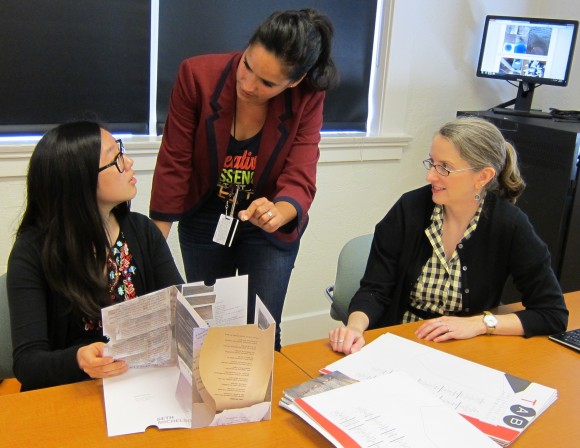
Professor of Art Claudine Jaenichen (middle) describes the interplay of time and space in
TAB: Volume Two
to Audrey Chang ’17 (left). Professor of English Anna Leahy, Ph.D. (right) explains how the content is selected, providing a wide range of poetic aesthetics.
Each journal was printed on one large press sheet, which was then hand-trimmed, folded and tab-punched. Nearly a dozen students helped glue all 700 books together, and went through about 117,000 inches of double-sided tape. The result: a book that doesn’t read anything like a traditional book. It’s almost confusing. But that’s the beauty of it. Jaenichen encourages the reader to touch, explore, feel, play with the content. There are no constraints and no specific “right” way to read
TAB.
“Through every step of the process, this was a very interactive publication. Hands have touched every single one of the journals, a key element in the user experience,” said Jaenichen.
It is by no means a sterile literary journal. Thanks to University support, nine MFA students attended the
Association of Writers and Writing Programs (AWP)
conference in February and passed out copies of
TAB: Volume Two.
Strikingly different from the other journals,
TAB
was received with rave reviews. With an unfamiliar spine, and unexpected vertical and horizontal movement,
TAB
had attendees getting “lost” in the content, exactly as Leahy and Jaenichen intended.
“The annual print journal engages the reader with poetry as a material object and asks that the reader negotiate between image and text,” said Jaenichen. The journal employs atmospheric and abstract photography of the sky taken at different times of the day. The presentation of text was specifically chosen to fit each individual poem.
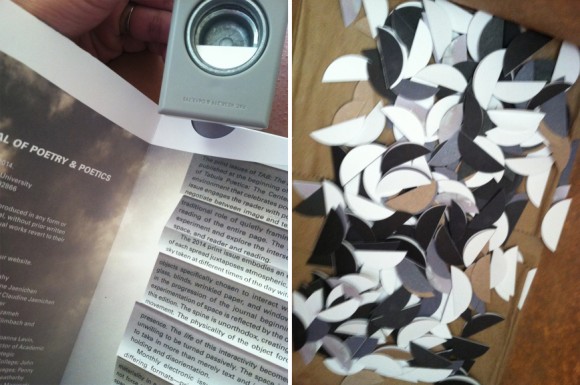
Left: For the design statement at the beginning of the journal, Jaenichen printed the text, glued each paragraph to slates on blinds, and took photos in the morning hours — an interaction of time and space. Right: Nearly a dozen students went through about 117,000 inches of double-sided tape, and tab-punched all 700 books.
There are no Photoshop effects. For the design statement at the beginning of the journal, Jaenichen printed the text, glued each paragraph to slates on blinds, and took photos in the morning — an interaction of time and space. Throughout the journal, text interacts with light on various other objects: water, glass, wrinkled paper, windows. By the end of the journal, the progression of time is reflected by the photographs of text taken at night.
Copies can be ordered by sending a check for $10 to
TAB: The Journal of Poetry & Poetics
, Department of English, Chapman University, One University Drive, Orange, CA 92866. Checks should be made out to Chapman University.
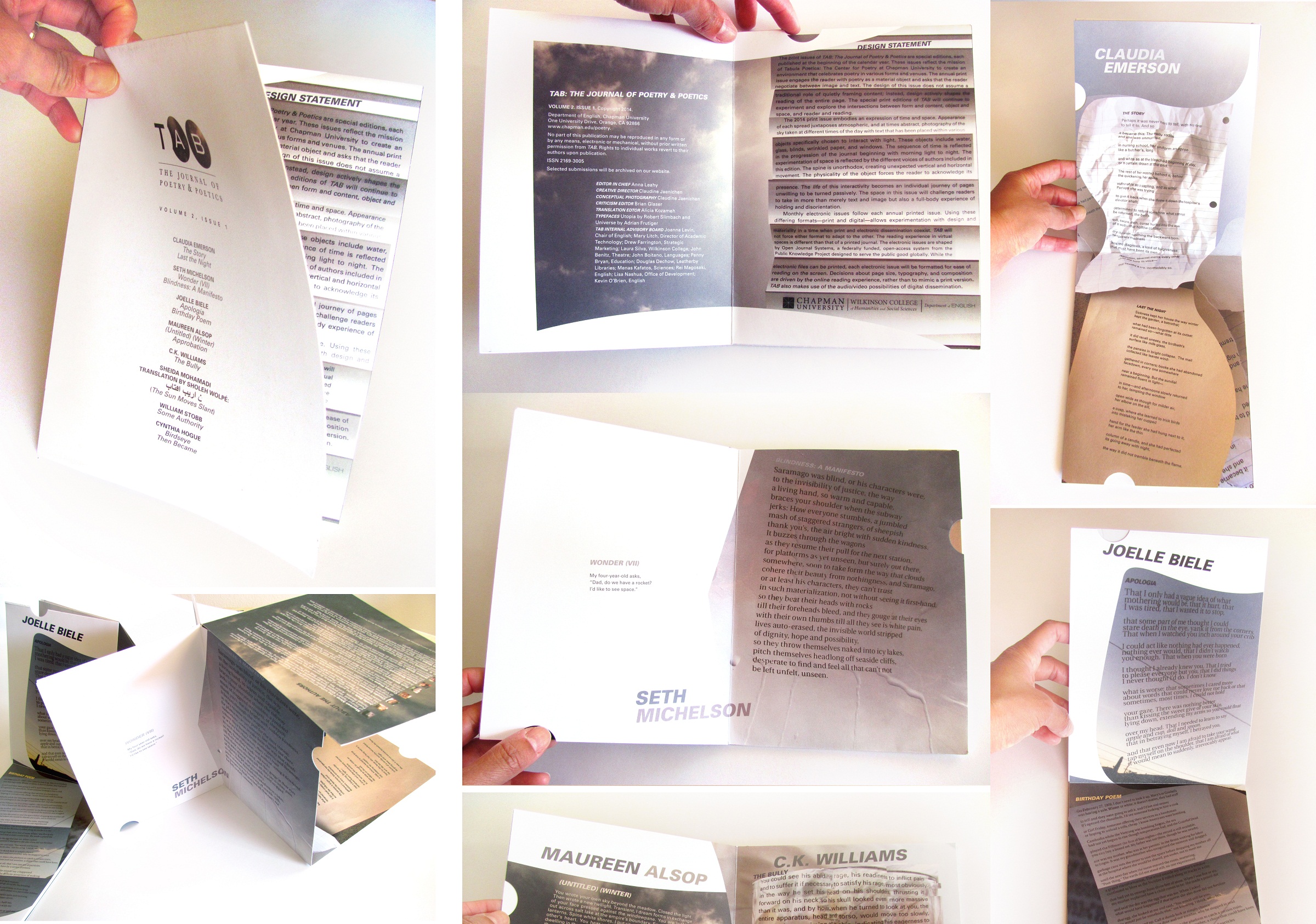

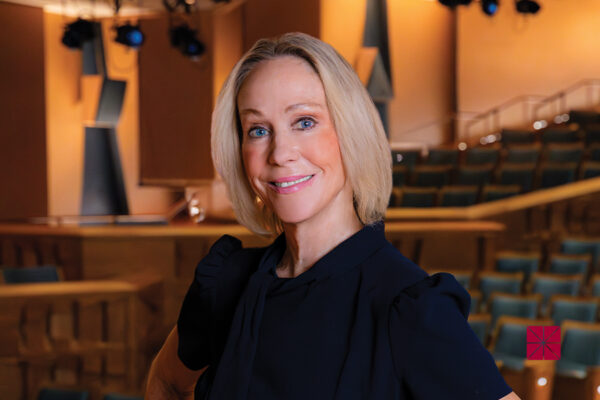
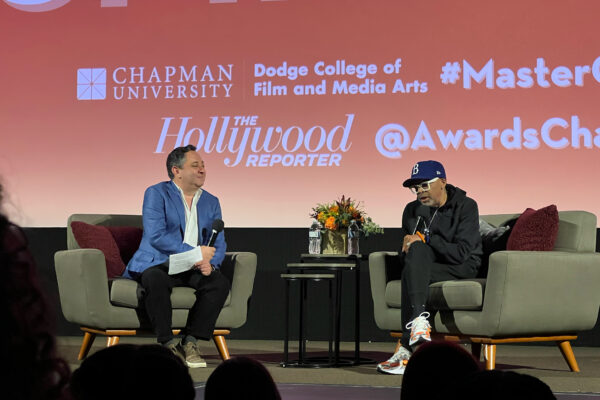

Add comment